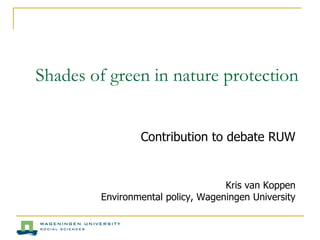Shades of green in nature protection - Kris van Koppen
- 1. Shades of green in nature protection Contribution to debate RUW Kris van Koppen Environmental policy, Wageningen University
- 2. Shades of green - the one-dimensional view despot --------------------- steward ---------------------- participant instrumental values -------------------------------- ŌĆ£intrinsic valuesŌĆØ cultural landscapes ---------------------------------------- wilderness
- 3. 3 Ecosystem services what is wild and morally valuable also provides the greatest economic benefits
- 4. 4 Socio-cultural values Socio-cultural values, in a specific sense, refer to non-use values in particular, and include: ’ü« importance of nature experiences to physical and mental health (restoration), ’ü« aesthetic, spectacular, scenic aspects of nature ’ü« inspiration of arts, thought ’ü« scientific interest, knowledge ’ü« heritage values and cultural identity ('nature monuments', 'patrimoine') ’ü« religious and spiritual values (sacred forests, old trees) ’ü« moral rights of existence
- 5. Appreciation of nature in arts revives in Renaissance, among urban elites .... Er is een diepgewortelde culturele traditie (al in het klassieke Rome en herlevend in de Renaissance) waarin natuur wordt gewaardeerd om haar schoonheid ("beautiful") en haar verhevenheid ("sublime") en als een plaats van rust en bezinning tegenover de hectiek van de stad en het hof. Salvator Rosa, (1615-1673)
- 6. ... and spreads over larger groups of citizens from the 18th century (industrial revolution) on Constable (1816), Wivenhoe Park
- 7. Over the 19th century, wilderness becomes the prevailing symbolic representation of 'real' nature.
- 8. Nature conservation: cultural symbols & cultural practices ’ü« Symbolic representations of nature - "Northern Aesthetic" (with an emphasis on wilderness) ’ü« Social practices of enjoying and protecting nature - gardening, pets, nature study, recreation, actively protecting. ’ü« Through these practices, cultural meanings of nature become part of everyday life in industrializes societies
- 9. Differentation of meanings and practices, from prehistoric France... ’ü« dependency ’ü« kinship ’ü« enjoyment & awe "the sorcerer", Trois Freres cave painting, tracing by H Breuil
- 11. 11 Local and global values: a more- dimensional view use values (regulation and provision) non-use values (socio- cultural) global / universal values - biosphere resilience - genetic information - global regulation functions - global stocks (e.g. fish) - moral rights of existence - world heritage local values - local regulation functions - local resource use - locally acknowledged cultural values
- 12. McShane et al. (Biological Conservation 2011) Hard choices ’ü« Win-win solutions are often difficult to realize. ’ü« Often trade-offs between 'human well-being' (read: local development) and conservation goals ’ü« "Resolving trade-offs is difficult, because social problems - of which conservation is one - can be perceived and understood in a variety of disparate ways" ’ü« Assumptions about the "right" approach often obscure differences in power and understanding. ’ü« Benefits, costs and trade-offs should be made explicit and negotiated
- 13. 13 Many other traditions of cultural valuation ’ü« Socio-cultural values depend on religion, but even more on social and material conditions ’ü« For societies highly dependent of nature (hunters & gatherers, peasants), socio- cultural values and use values are intertwined ’ü« In many societies, elites at a distance of nature (cities, courts) developed 'arcadian'-like values. ’ü« A typical difference between many other traditions and the Western one is that they give less priority to wilderness in comparison to cultivated landscapes. ’ü« But this may well change with further industrialization and modernization Dong Yuan (~ 900)













